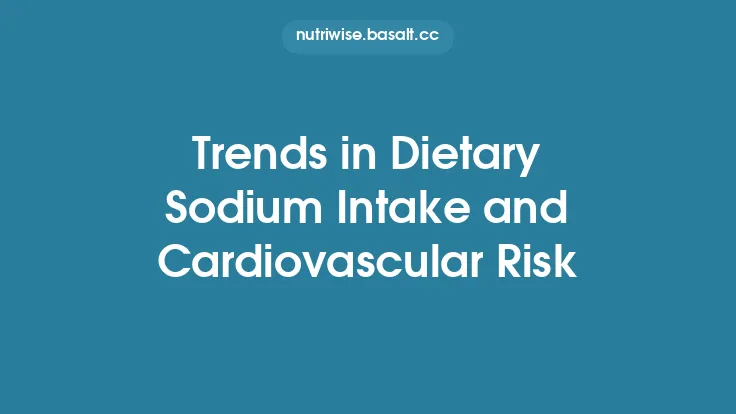Nutrition research has long grappled with the difficulty of establishing true cause‑and‑effect relationships between dietary exposures and health outcomes. Observational studies are vulnerable to confounding, measurement error, and reverse causation, which can obscure the underlying biology and lead to contradictory findings. Mendelian randomization (MR) offers a powerful genetic epidemiology framework that leverages the random assortment of alleles at conception to emulate the conditions of a randomized controlled trial. By using genetic variants as proxies (instrumental variables) for nutritional exposures, MR can provide more robust causal estimates while sidestepping many of the pitfalls that plague conventional epidemiology. This article explores the methodological advances that have sharpened MR’s utility in nutrition research, outlines practical steps for implementing MR studies, and highlights emerging directions that promise to further improve causal inference in this field.
The Core Principles of Mendelian Randomization
Instrumental Variable Assumptions
For a genetic variant to serve as a valid instrument, three core assumptions must hold:
- Relevance – The variant is robustly associated with the nutritional exposure of interest (e.g., circulating vitamin D levels, plasma omega‑3 fatty acids).
- Independence – The variant is independent of confounders that could bias the exposure–outcome relationship (e.g., socioeconomic status, lifestyle factors).
- Exclusion Restriction – The variant influences the health outcome only through the exposure, not via alternative pathways (i.e., no horizontal pleiotropy).
Violations of these assumptions can bias MR estimates, so modern MR studies incorporate a suite of sensitivity analyses and methodological refinements to detect and mitigate such violations.
Why Randomization Matters
Because alleles are allocated randomly at meiosis, the distribution of genetic variants is, in principle, unrelated to environmental confounders. This “natural randomization” mimics the allocation process of a clinical trial, allowing researchers to infer causality without intervening directly on participants’ diets—a particularly valuable feature when dietary manipulation is impractical or unethical.
Selecting and Validating Genetic Instruments for Nutritional Exposures
Genome‑Wide Association Studies (GWAS) as a Source of Instruments
Large‑scale GWAS have identified dozens of loci linked to biomarkers of nutrient status (e.g., serum ferritin, plasma carotenoids, circulating choline). When choosing instruments, researchers now prioritize:
- Genome‑wide significance (p < 5 × 10⁻⁸) to ensure strong relevance.
- Replication across independent cohorts to guard against winner’s curse.
- Biological plausibility, such as variants in genes encoding transporters, enzymes, or receptors directly involved in nutrient metabolism.
Strength Assessment
The F‑statistic (or its equivalent, the proportion of variance explained, R²) quantifies instrument strength. An F‑statistic > 10 is generally considered sufficient to avoid weak‑instrument bias, though recent guidance recommends reporting the exact value and, when possible, using multiple independent variants to increase power.
Pleiotropy Detection and Mitigation
Horizontal pleiotropy—where a variant influences the outcome through pathways other than the exposure—remains the chief threat to MR validity. Contemporary strategies include:
- Phenome‑wide association scans (PheWAS) to catalog all known phenotype associations of candidate variants.
- Bioinformatic annotation (e.g., using GTEx, eQTL databases) to identify variants that affect gene expression in tissues unrelated to the nutrient pathway.
- Statistical methods such as MR‑Egger regression, weighted median, and mode‑based estimators that provide consistent causal estimates under specific pleiotropy patterns.
Advanced MR Designs Tailored to Nutrition Research
Two‑Sample MR
Two‑sample MR leverages summary statistics from separate GWAS: one for the exposure and another for the outcome. This design dramatically expands sample size, enabling the investigation of rare outcomes (e.g., specific cancers) and allowing researchers to combine data from consortia that would otherwise be inaccessible. Key considerations include:
- Population matching to avoid bias from differing allele frequencies or linkage disequilibrium (LD) structures.
- Harmonization of effect alleles to ensure consistent directionality across datasets.
- Use of LD‑clumping to retain only independent variants (commonly r² < 0.01 within a 10 Mb window).
Multivariable MR (MVMR)
Nutritional exposures often coexist (e.g., saturated fat and cholesterol) and may confound each other’s effects. MVMR extends the classic MR framework by simultaneously modeling multiple exposures, thereby estimating the direct causal effect of each while accounting for the others. This approach is especially valuable for:
- Disentangling correlated nutrients (e.g., distinguishing the effect of dietary fiber from that of whole‑grain intake).
- Assessing mediation (e.g., whether the effect of vitamin D on bone health is mediated through calcium absorption).
Non‑Linear MR
Traditional MR assumes a linear relationship between exposure and outcome, which may not hold for nutrients that exhibit threshold or U‑shaped effects (e.g., iron, vitamin A). Non‑linear MR methods, such as fractional polynomial MR or stratified MR based on exposure quantiles, enable researchers to explore dose‑response curves and identify optimal intake ranges.
MR Using Polygenic Scores
When single‑variant instruments are weak or unavailable, polygenic risk scores (PRS) aggregating many SNPs can serve as a composite instrument. Recent methodological work demonstrates that, provided the PRS satisfies the instrumental assumptions, it can increase power while still allowing pleiotropy‑robust sensitivity analyses.
Practical Workflow for Conducting an MR Study in Nutrition
- Define the Nutritional Exposure
- Choose a biologically relevant biomarker (e.g., plasma lutein) rather than a self‑reported intake measure, because genetic variants typically influence circulating levels.
- Identify GWAS Sources
- Prioritize large, well‑characterized GWAS with ancestry-matched participants. Public repositories such as the GWAS Catalog, IEU OpenGWAS, and the UK Biobank provide ready‑to‑use summary data.
- Select Instruments
- Apply genome‑wide significance thresholds, LD‑clumping, and strength checks (F‑statistic). Document each variant’s effect allele, beta, standard error, and proportion of variance explained.
- Assess Pleiotropy
- Conduct PheWAS, review functional annotations, and run MR‑Egger intercept tests. Exclude variants with strong evidence of horizontal pleiotropy or perform robust MR methods that down‑weight them.
- Harmonize Datasets
- Align exposure and outcome alleles, resolve strand ambiguities, and ensure consistent units (e.g., convert β coefficients to per‑standard‑deviation change).
- Primary MR Analysis
- Use inverse‑variance weighted (IVW) regression as the main estimator, supplemented by weighted median and MR‑Egger for robustness.
- Sensitivity Analyses
- Perform leave‑one‑out analyses, heterogeneity tests (Cochran’s Q), and MR‑PRESSO to detect outlier instruments.
- Interpretation
- Translate causal estimates into clinically meaningful terms (e.g., “each 1‑SD increase in circulating omega‑3 fatty acids reduces coronary artery disease risk by 12%”). Discuss assumptions, limitations, and potential biological mechanisms.
- Replication
- Validate findings in an independent two‑sample MR using different GWAS or in a one‑sample MR within a large cohort (e.g., UK Biobank) where individual‑level data are available.
Common Pitfalls and How to Avoid Them
| Pitfall | Why It Matters | Mitigation Strategy |
|---|---|---|
| Using self‑reported intake as the exposure | Genetic variants influence physiology, not recall bias; self‑report introduces measurement error that weakens instrument relevance. | Prefer biomarkers (e.g., plasma concentrations) or validated metabolite proxies. |
| Population stratification | Ancestry differences can create spurious associations between genotype and outcome. | Restrict analyses to a single ancestry, adjust for principal components, or use trans‑ethnic MR methods that model heterogeneity. |
| Weak instruments | Inflates Type I error and biases estimates toward the null. | Ensure F‑statistic > 10, combine multiple independent SNPs, or use strong PRS. |
| Undetected pleiotropy | Violates exclusion restriction, leading to biased causal inference. | Apply a suite of pleiotropy‑robust methods (MR‑Egger, weighted median, MR‑PRESSO) and conduct thorough functional annotation. |
| Over‑reliance on a single GWAS | Results may be driven by cohort‑specific biases or measurement quirks. | Use multiple GWAS for the same exposure when available; perform meta‑MR across studies. |
Illustrative Applications in Nutrition Research
- Vitamin D and Cardiovascular Disease
Two‑sample MR using SNPs in *GC, DHCR7, and CYP2R1* demonstrated a modest protective effect of higher circulating 25‑hydroxyvitamin D on myocardial infarction risk, independent of confounding by physical activity or sun exposure.
- Omega‑3 Fatty Acids and Depression
Multivariable MR that simultaneously modeled EPA and DHA levels clarified that EPA, rather than DHA, drives the observed inverse association with major depressive disorder, informing targeted supplementation strategies.
- Iron Status and Type‑2 Diabetes
Non‑linear MR revealed a J‑shaped relationship: both low and high genetically predicted ferritin concentrations increased diabetes risk, underscoring the need for individualized iron management.
- Folate and Neural Tube Defects
Polygenic MR using a PRS for plasma folate confirmed a dose‑dependent reduction in neural tube defect incidence, supporting public‑health policies on folic acid fortification.
These examples illustrate how MR can move beyond correlation, providing actionable insights for dietary guidelines, supplementation policies, and mechanistic research.
Emerging Frontiers
Integration with Metabolomics (Beyond the Scope of Biomarker Validation)
While metabolomics is often discussed as a tool for objective dietary assessment, its role as a source of intermediate phenotypes for MR is expanding. By treating metabolite concentrations as exposures, researchers can map causal pathways from diet → metabolite → disease, thereby dissecting complex nutritional mechanisms without relying on self‑report.
Bidirectional MR for Reverse Causation Checks
Bidirectional MR tests whether the outcome may also influence the exposure (e.g., whether obesity genetically predisposes individuals to altered nutrient metabolism). This approach helps rule out reverse causation, a common concern in nutrition epidemiology.
MR in Diverse Populations
Most MR studies have focused on European ancestry cohorts. Ongoing efforts to generate GWAS data in African, Asian, and Hispanic populations will enable trans‑ethnic MR, improving generalizability and uncovering ancestry‑specific nutrient–disease relationships.
Machine‑Learning‑Assisted Instrument Selection
Although machine learning is a separate methodological domain, recent pipelines use penalized regression and Bayesian variable selection to identify optimal sets of SNPs for a given nutrient exposure, balancing instrument strength against pleiotropy risk.
Concluding Thoughts
Mendelian randomization has matured from a niche technique into a cornerstone of causal inference in nutrition research. By harnessing genetic variants as unbiased proxies for dietary exposures, MR circumvents many of the limitations inherent to observational studies. Recent methodological advances—two‑sample designs, multivariable and non‑linear extensions, robust pleiotropy diagnostics, and polygenic instruments—have broadened the scope of questions that can be addressed, from nutrient‑specific disease risk to optimal intake thresholds.
For researchers embarking on MR investigations, the key lies in rigorous instrument selection, comprehensive sensitivity testing, and transparent reporting of assumptions. When applied thoughtfully, MR not only strengthens the evidence base for nutritional recommendations but also illuminates the biological pathways through which diet shapes health. As genomic resources continue to expand and analytical tools become more sophisticated, Mendelian randomization will remain an evergreen, ever‑evolving pillar of methodological innovation in nutrition science.





